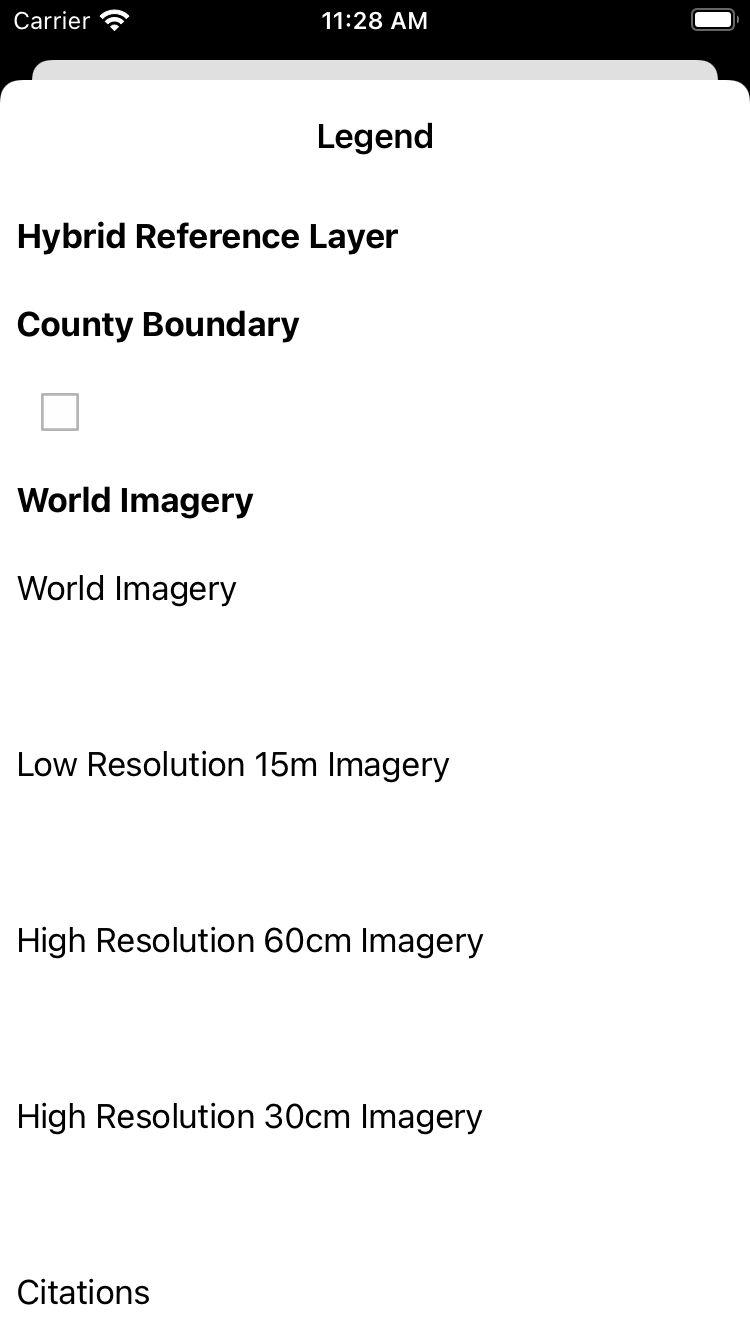The ArcGIS Runtime SDK for iOS Toolkit contains components that will simplify your iOS app development. Check out the Examples project to see these components in action or read through the Documentation to learn more about them.
Try ArcGIS Maps SDK for Swift version 200
ArcGIS Runtime SDK for iOS version 100.15 is a long-term support release focused exclusively on bug fixes and minor updates.
ArcGIS Maps SDK for Swift version 200 builds on the proven architecture of 100.15, and provides a new API designed exclusively for developing iOS apps using Swift - Apple's modern, powerful, and intuitive programming language.
To use Toolkit in your project:
- Install with Swift Package Manager - Add
https://github.com/Esri/arcgis-runtime-toolkit-iosas the package repository URL. - Install with CocoaPods - Add
pod 'ArcGIS-Runtime-Toolkit-iOS'to your podfile - Build manually - Build and include manually if you'd like to customize or extend toolkit
- Augmented reality (AR) - Integrates the scene view with ARKit to enable augmented reality (AR).
- Bookmarks - Shows bookmarks, from a map, scene, or a list.
- Compass - Shows a compass direction when the map is rotated. Auto-hides when the map points north up.
- FloorFilter - Allows to filter floor plan data in a geo view by a site, a building in the site, or a floor in the building.
- JobManager - Suspends and resumes ArcGIS Runtime tasks when the app is background, terminated, and relaunched.
- LegendViewController - Displays a legend for all the layers in a map or
scene contained in an
AGSGeoView. - MeasureToolbar - Allows measurement of distances and areas on the map view.
- PopupController - Display details and media, edit attributes, geometry and related records, and manage the attachments of features and graphics (popups are defined in the popup property of features and graphics).
- Scalebar - Displays current scale reference.
- TemplatePickerViewController - Allows a user to choose a template from a list of
AGSFeatureTemplatewhen creating new features. - TimeSlider - Allows interactively defining a temporal range (i.e. time extent) and animating time moving forward or backward. Can be used to manipulate the time extent in a MapView or SceneView.
- ArcGIS Runtime SDK for iOS 100.15.0 (or higher)
- Xcode 13.0 (or higher)
The ArcGIS Runtime Toolkit for iOS has a Target SDK version of 14.0, meaning that it can run on devices with iOS 14.0 or newer.
- Open your project in Xcode
- Go to File > Swift Packages > Add Package Dependency option
- Enter
https://github.com/Esri/arcgis-runtime-toolkit-iosas the package repository URL - Choose version 100.15.0 or a later version. Click Next.
Note: The Toolkit Swift Package adds the ArcGIS SDK Swift Package as a dependency so no need to add both separately. If you already have the ArcGIS SDK Swift Package delete that and just add the Toolkit Swift Package.
New to Swift Package Manager? Visit swift.org/package-manager/.
- Add
pod 'ArcGIS-Runtime-Toolkit-iOS'to your podfile - Run
pod install. This will download the toolkit and the ArcGIS Runtime SDK for iOS which the toolkit depends upon and then configure your project to reference them both - Add
import ArcGISToolkitin your source code and start using the toolkit components
New to cocoapods? Visit cocoapods.org
- Clone or download this repo
- Drag and Drop the
arcgis-runtime-toolkit-iosfolder into your project through the Xcode Project Navigator pane - Add the ArcGISToolkit library in your app, by adding it to the Frameworks, Libraries, and Embedded Content section of the General pane for your app target. The ArcGISToolkit library contains the ArcGIS Runtime SDK for iOS library, so you don't need to add that separately.
- Add
import ArcGISandimport ArcGISToolkitin your source code and start using the toolkit components
Note: The manual installation method also allows you to use a local installation ArcGIS Runtime SDK for iOS by making minor edits to the swift package.
Some of the toolkit components and examples utilize a set of ready-to-use ArcGIS Platform services, including basemaps, and therefore require an API Key to be set in AppDelegate.swift. Please see the setup guide for more information.
Both the Toolkit and Examples app support SwiftLint. You can install SwiftLint from
here. It is not necessary to have it installed in order to build, but you will
get a warning without it. The specific rules the linter uses can be found in the swiftlint.yml files in the Toolkit
and Examples directories.
- Developers guide documentation
- Runtime API Reference
- Samples
- Got a question? Ask the community on our forum
Find a bug or want to request a new feature? Please let us know by submitting an issue.
Esri welcomes contributions from anyone and everyone. Please see our guidelines for contributing.
Copyright 2017 - 2022 Esri
Licensed under the Apache License, Version 2.0 (the "License"); you may not use this file except in compliance with the License. You may obtain a copy of the License at
http://www.apache.org/licenses/LICENSE-2.0
Unless required by applicable law or agreed to in writing, software distributed under the License is distributed on an "AS IS" BASIS, WITHOUT WARRANTIES OR CONDITIONS OF ANY KIND, either express or implied. See the License for the specific language governing permissions and limitations under the License.
A copy of the license is available in the repository's LICENSE file.
















